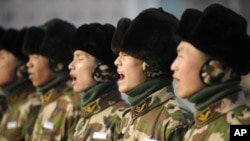The U.S. military issued its first new overall strategy document in six years on Tuesday, calling for the development of a force that is more focused on Asia, where the document says economic and military power are growing, and the strategic environment is changing quickly.
Today’s world presents a challenging and fast-changing security environment that requires enhanced leadership from the U.S. military, an approach involving civilian and military power, and more partnerships with countries around the world, according to the National Military Strategy.
The 21-page document issued by America's top military leadership builds on strategies issued by the White House and the Pentagon’s civilian leaders. The military strategy outlines the role the U.S. Army, Navy, Air Force and Marine Corps will play in securing the country for years to come.
“You have to posture the force to where you think the risk is going to be, against the type of risk that you expect to see,” said Rear Admiral John Roberti of the military’s Strategy and Policy Office. He says the new strategy focuses on Asia because the global economy is shifting toward the region, there are rising military powers there and, he says, political change is happening.
“We need to look at defense posture there, our capabilities that are located there, our relationships, our partnerships, our allies, and focus on that area to maintain security. I wouldn’t focus on where there’s more troops or less troops, but [rather] what are the capabilities and the posture of those capabilities with that region.”
The strategy notes China in particular, and says the U.S. military must be prepared to respond to what are called anti-access capabilities, which China is expanding quickly. Such capabilities can threaten global trade routes and restrict the ability of the U.S. military to do whatever American leaders might order it to do.
The document also cites such factors as weapons proliferation, globalization, natural disasters, climate change, cyber crime, resource shortages, pandemic disease, trade disputes and violent extremist groups as key factors in the global strategic environment - all of which, Roberti says, are present in Asia.
“The intersection of those challenges develops a risk that we must posture differently for, we must plan differently for and we must certainly take into account in the current plans,” he said.
In addition to developing appropriate fighting capabilities, the strategy says the U.S. military must take the lead in bringing together U.S. government agencies and foreign military and civilian partners, including non-governmental organizations, to tackle problems that threaten stability and security.
In particular, it calls for working with regional organizations in Africa and South America to promote security and stability in those regions. And although it was written before the current unrest in Tunisia and Egypt, the document cites the need to address potential instability in the Middle East because of governance problems and shifting economic, political, social and cultural factors.
The document is in part a look ahead at priorities for the U.S. military beyond the wars in Iraq, where U.S. forces are scheduled to leave this year, and Afghanistan, where U.S. troops will start leaving this year, with the goal of substantial withdrawal by 2014. Military leaders will use the strategy as a basis for planning, including requests for new or expanded weapons programs that will likely be difficult to fund given the anti-spending atmosphere in the U.S. Congress.







